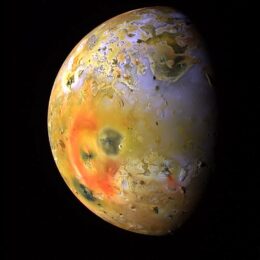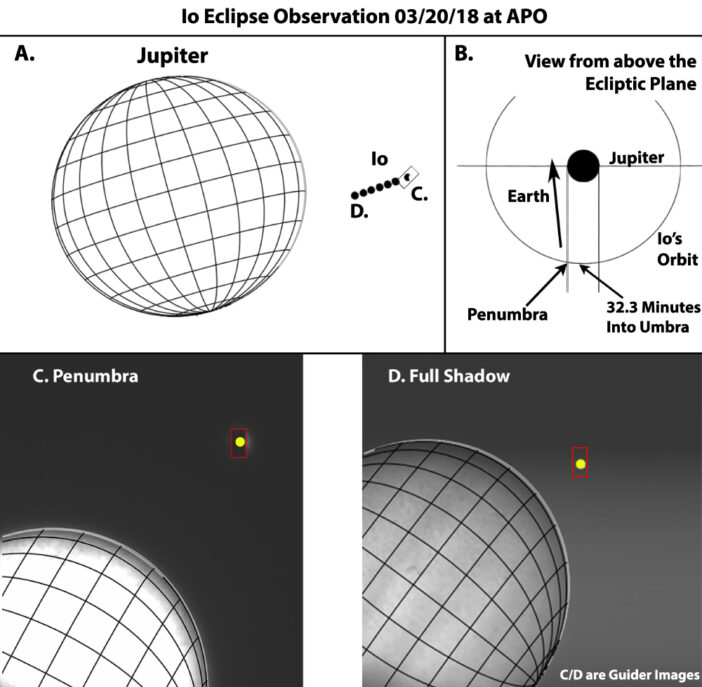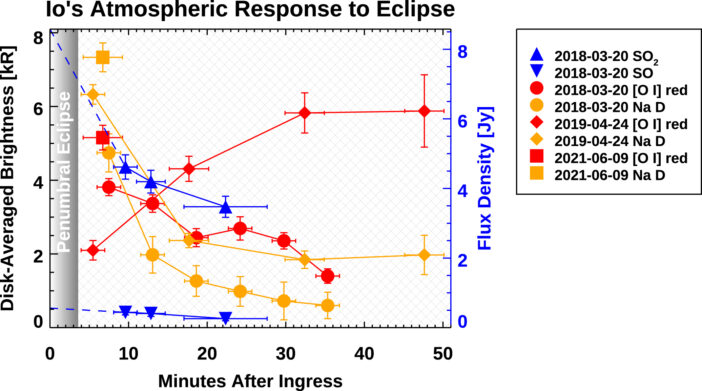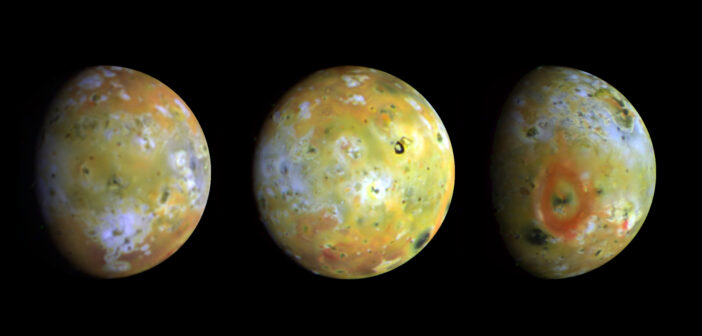Editor’s Note: Astrobites is a graduate-student-run organization that digests astrophysical literature for undergraduate students. As part of the partnership between the AAS and astrobites, we occasionally repost astrobites content here at AAS Nova. We hope you enjoy this post from astrobites; the original can be viewed at astrobites.org.
Title: Io’s Optical Aurorae in Jupiter’s Shadow
Authors: Carl Schmidt et al.
First Author’s Institution: Boston University
Status: Published in PSJ

Figure 1: Jupiter’s innermost Galilean moon, Io. Its yellowish color mainly comes from sulfur on the surface. [NASA/JPL/University of Arizona]
Iororae?
In addition to volcanoes, Io has aurorae (not iororae, sadly, missed opportunity there), but they are different from Earth’s. Io’s version is not directly caused by the Sun, but rather by Jupiter’s enormous magnetic field, which is about 20,000 times stronger than Earth’s. Earth’s atmosphere is also very different from Io’s (luckily). The many volcanoes on Io spew out large amounts of sulfur dioxide (SO2), which makes up a large part of the moon’s atmosphere. This molecule gets shredded by a multitude of processes, releasing electrons and ions all around, causing aurorae to appear and helping to form Io’s plasma ring around Jupiter.
If we want to know more about this plasma ring and Jupiter’s enormous magnetic field, we need to figure out how the SO2 in Io’s atmosphere behaves and interacts with other molecules and atoms. In daylight, the Sun’s radiation splits up (dissociates) most of the SO2, but what happens to SO2 during night time? There’s no way we can see Io’s night side without sending very expensive spacecraft up there. However, as it so happens, Io passes through Jupiter’s shadow approximately every 42 hours. During the shadow passage, the surface cools down a lot, and the Sun’s radiation will no longer break down molecules. This closely resembles night time on Io, allowing us to see how the rest of the atmosphere reacts at night, if at all.
Turns out, Io has impressive aurorae during the Jupiter eclipse. Now, to see these aurorae we mostly need to be able to observe ultraviolet light, which we can only see with space telescopes. Also, ultraviolet radiation doesn’t tell us everything, and there could be more to see with optical light as well. To view Io’s aurorae in optical light is challenging, though: we can’t directly see Io in Jupiter’s shadow, which makes it hard for telescopes to track the moon’s position. The authors of today’s article managed to see Io’s aurorae in optical light using ground-based telescopes. The authors waited for Io to pass into Jupiter’s shadow as only then are the optical aurorae visible (similar to here on Earth, Io’s aurorae aren’t very visible during the day).
Spotting Io’s Aurorae 101
As you might imagine, seeing Io’s aurorae is even harder than seeing Earth’s. Most of the time when Io is eclipsed by Jupiter, there’s this giant planet in the way blocking our view. But luckily, this is not always the case. When the positions of the Sun, Earth, and Jupiter form a right triangle (fancy astronomer slang: Earth and Jupiter being at quadrature), we can still “see” Io once it enters Jupiter’s shadow (more fancy astronomer slang: at ingress) or just before exit (egress). This is shown in Fig. 2, where a distinction is made between the full shadow (umbra) and the partial shadow (penumbra).

Figure 2: Panel A shows where in Io’s orbit around Jupiter you would see panels C and D, as seen from Earth. Panel B shows Io’s orbit from above the ecliptic plane. Panels C and D show the observations of Io when it’s in partial and in full shadow, respectively (the yellow dot is where the instrument thinks Io is). [Schmidt et al. 2023]

Figure 2: Light intensity of oxygen (red) and sodium (orange) on three different observation nights (circles, diamonds, squares), along with SO2 and SO intensities on one night. [Schmidt et al. 2023]
On the other hand, sodium and SO2 do seem to align, both declining once Io passes into Jupiter’s shadow. To understand why, it’s important to know that the atomic sodium comes mostly from molecules on Io, namely sodium chloride (aka salt). Once the eclipse starts, SO2 gas in the atmosphere freezes out as SO2 ice and subsequently falls down on Io’s surface almost like snow (no snow sculptures here, though; this stuff is very bad for your health). This snow buries the sodium chloride on Io, preventing sodium from showing up in the spectral lines — hence the decline in sodium brightness.
Despite all the difficulties with spotting them, we can nevertheless pull a lot of information from Io’s optical aurorae. Today’s authors demonstrated this by shedding light on the otherwise unobservable night side on Io. The fact that the authors managed to see Io’s aurorae in the optical and from the ground also opens up the possibility to study Io more frequently, which will undoubtedly lead to more interesting results in the future. Io never fails to surprise!
Original astrobite edited by Konstantin Gerbig.
About the author, Roel Lefever:
Roel is a second-year PhD student at Heidelberg University, studying astrophysics. He works on massive stars and simulates their atmospheres/outflows. In his spare time, he likes to hike/bike in nature, swimming, video games, to play/listen to music, and to read (currently The Wheel of Time, but any fantasy/sci-fi really).

